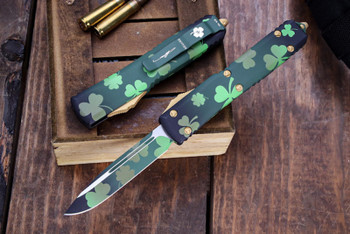Summer Stock List: Great Blades for the Fall Hunting Season
Posted by Clayton on Dec 6th 2016
Few tools are as versatile as the hunting knife. From skinning an animal, to slicing up the meat, to general camp utility, you can make your hunting experience more enjoyable by choosing the right knife.
With the fall hunting season rapidly approaching, maybe it’s time you brushed up on your blades and bulked up your collection.Uses for Hunting Knives
Are you making full use of your hunting knives? Here are some of the many ways that a smart hunter can fully utilize their blades. Often, the type of blade you need depends on its application.
Hunting: Although modern hunting blades aren’t usually for the hunt itself, you may still use a special type of blade for boar hunting that is designed with a stabbing rather than slicing motion in mind.
Gutting: With many types of game, gutting an animal is the first thing you need to do to preserve the meat. Gutting knives generally have a gut hook to cut an animal open and remove the organs.
Skinning: Skinning knives typically have short, thin blades to avoid damaging muscles and other tissues you want to keep intact when cutting through an animal’s skin.
Deboning: Whether it’s a fish or a deer, once an animal is gutted and skinned you’ll need a blade to help remove the meat from the bone.
Butchering: There are many methods for cutting up an animal’s meat, but what they all have in common is the importance of making a clean cut. As an all-in-one hunting knife, Bowie knives are a good choice.
Caping: Caping is the process of skinning an animal to prepare its head for mounting a hunting trophy.
Types of Blades
A seasoned hunter knows his or her blade. Here are some of the types of hunting blades and their best uses.
Bowie Knife or Clip Point Blade: A Bowie knife is a good all-purpose blade. The sharp point can pierce flesh with ease, but it is also rather narrow, which can result in a weaker blade. The shape is distinctive: straight at the top, the middle of the blade curves all the way down to the super-sharp tip.
Drop Point Blade Knife: Though its tip is duller than that of a Bowie knife, reducing its capacity to pierce an animal’s skin, a drop point blade can be a good choice when it comes to skinning, as they offer the hunter more control and thus reduce the probability of damaging the quality of the meat. A drop-point blade knife’s spine gradually slopes down to the tip.
Trailing Point or Skinning Blade: This lightweight blade’s back spine curves upward and gives the hunter a large slicing area. This kind of blade is great for delicate work and is often found on a skinning or fillet knife. They are designed specifically for skinning and slicing.
Spear Point Blades: With its symmetrical shape and sharp point, the spear point blade is great for hunting. As their name suggests, they are designed for ease of piercing and stabbing, but this kind of blade is not ideal for slicing or skinning.
Gut Hook or Zipper Knife: As their name suggests, gut hook knives are great for gutting, in addition to being a great option for skinning. The hook at the top allows the hunter to open the animal’s stomach without puncturing any organs or damaging the muscles. On the downside, it is difficult to sharpen the hook, which may reduce the knife’s long-term viability.
How to Choose
The size and shape of the hunting blade you should use depends on the game you will be hunting. For a large game like a bear, a drop-point skinning knife with a blade of 3.5 inches or more ought to do the trick. However, for smaller game like a fish, you’ll want something a bit more delicate. A filet knife may be the answer, providing the hunter with strength and precision when gutting and filleting a fish.
Of course, what matters when choosing a hunting knife is what feels good. How does the handle feel in your hand? If it’s uncomfortable, it won’t be useful when hunting. You should look for durability in a knife handle. Although wood, leather, and bone handles may be more visually pleasing, synthetic materials won’t be as difficult to grip when wet.
Final Thoughts
With these guidelines and tips, you can optimize this fall’s hunting season and wind up with better-prepared game. Know the dates, sharpen your blades, stock up on new knives, and make it the best hunting season yet!

